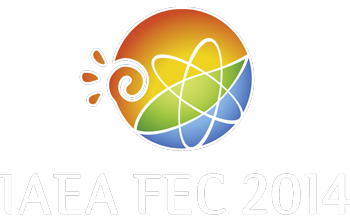Speaker
Dr
Henry R. Strauss
(HRS Fusion)
Description
In several experiments, including JET [1], Alcator C-Mod [2], and NSTX [3], it was observed that disruptions were accompanied by toroidal rotation. There is a concern that there may be a resonance between rotating toroidal perturbations and the resonant frequencies of the ITER vacuum vessel, causing enhanced damage. We present MHD simulations with M3D [4] of ITER, JET, and DIII-D, as well as theory, demonstrating that asymmetric vertical displacement event (AVDE) disruptions and ELMs can produce toroidal rotation. Net toroidal rotation requires three conditions [5].
(1) The poloidal magnetic field penetrates the wall, which is a condition that the plasma can transmit torque to the wall.
(2) Rotation requires vertical asymmetry, which can be produced by a VDE. Simulations and theory indicate that the magnitude of the rotation is a stong function of VDE displacement.
(3) Rotation requires MHD turbulence. In disruption simulations, the thermal quench and rotation generation occur at the same time, and are caused by toroidally varying MHD perturbations. The rotation persists into the current quench.
This work was supported in part by the U.S.D.O.E., ITER and F4E.
[1] S. N. Gerasimov, et. al, Proc. of EPS 37th Conference on Plasma Physics, Dublin, Ireland (2010).
[2] R. S. Granetz, et. al, Nucl. Fusion 36, 545 (1996).
[3] S. P. Gerhardt, et. al, Nucl. Fusion 52 063005 (2012).
[4] W. Park, E. Belova, G. Y. Fu, X. Tang, H. R. Strauss, L. E. Sugiyama, Phys. Plasmas 6 1796 (1999).
[5] H. Strauss, L. Sugiyama, R. Paccagnella, J. Breslau, S. Jardin, Nucl. Fusion, in press (2014).
| Country or International Organisation | USA |
|---|---|
| Paper Number | TH/P2-16 |
Author
Dr
Henry R. Strauss
(HRS Fusion)
Co-authors
Dr
J. Breslau
(Princeton Plasma Physics Laboratory)
Dr
L. Sugiyama
(MIT)
Dr
R. Paccagnella
(Consorzio RFX and Istituto Gas Ionizzati ( C.N.R. ), Padua, Italy)
Dr
S. Jardin
(Princeton Plasma Physics Laboratory)

